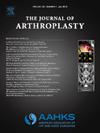Increased Involvement of Staphylococcus epidermidis in the Rise of Polymicrobial Periprosthetic Joint Infections
IF 3.4
2区 医学
Q1 ORTHOPEDICS
引用次数: 0
Abstract
Background
In this study, we aimed to analyze the temporal distribution of polymicrobial periprosthetic joint infections (PJIs), while also evaluating the patient risk factors associated with these infections following total joint arthroplasty at our institution across 2 distinct periods.
Method
This retrospective cross-sectional study evaluated 259 patients who had knee or hip PJI from 2001 to 2006 and 2018 to 2022. A PJI was diagnosed using the 2018 International Consensus Meeting criteria. We utilized the Polymicrobial Pathogens' Co-occurrence Network Analysis, a novel approach that leverages network theory to map and quantify the complex interplay of organisms in PJIs.
Results
Of the 259 patients who had polymicrobial PJI, 58.7% were men, with mean age 67 years (range, 24 to 90). Of the 579 identified pathogens, Staphylococcus epidermidis was the most common (22.1%), followed by Staphylococcus aureus (9.0%) and Cutibacterium acnes (7.8%). The co-occurrence analysis indicated that Staphylococcus epidermidis frequently coexisted with Cutibacterium acnes (26 cultures) and Staphylococcus capitis (22 cultures). A notable increase in body mass index from 27.7 ± 4.4 in 2001 to 2006 to 29.7 ± 6.2 in 2018 to 2022 was observed (P = .001). Moreover, infections from Staphylococcus epidermidis, Cutibacterium acnes, and Staphylococcus capitis saw a significant uptick (P < .001).
Conclusions
The study shows that from 2001 to 2022, there was a significant change in the pathogens responsible for polymicrobial PJIs, particularly an increase in Staphylococcus epidermidis, Cutibacterium acnes, and Staphylococcus capitis. Alongside these microbial changes, there was a rise in body mass index and shifts in comorbid conditions, such as more renal disease and fewer cases of congestive heart failure. These changes highlight the dynamic interplay between host and microbial factors in the pathogenesis of polymicrobial PJIs, necessitating adaptive strategies in both surgical and postoperative care to mitigate the rising tide of these complex infections.
多微生物假体周围关节感染的增加与表皮葡萄球菌的参与有关。
背景:在这项研究中,我们旨在分析多微生物假体周围关节感染(PJI)的时间分布,同时评估本机构在两个不同时期进行全关节置换术后与这些感染相关的患者风险因素:这项回顾性横断面研究评估了 2001 年至 2006 年和 2018 年至 2022 年的 259 名膝关节或髋关节 PJI 患者。假体周围关节感染采用2018年国际共识会议标准进行诊断。我们采用了多微生物病原体共现网络分析法,这是一种利用网络理论绘制并量化PJI中复杂的生物相互作用的新方法:结果:在259名患有多微生物PJI的患者中,58.7%为男性,平均年龄为67岁(24至90岁)。在已确定的 579 种病原体中,最常见的是表皮葡萄球菌(22.1%),其次是金黄色葡萄球菌(9.0%)和痤疮杆菌(7.8%)。共存分析表明,表皮葡萄球菌经常与痤疮棒状杆菌(26 份培养物)和头癣葡萄球菌(22 份培养物)共存。体质指数从 2001 年至 2006 年的 27.7 ± 4.4 显著上升至 2018 年至 2022 年的 29.7 ± 6.2(P = 0.001)。此外,表皮葡萄球菌、痤疮杆菌和头癣葡萄球菌的感染率也显著上升(P < 0.001):研究结果表明,从 2001 年到 2022 年,导致多微生物肺炎球菌感染的病原体发生了显著变化,尤其是表皮葡萄球菌、痤疮棒状杆菌和头状葡萄球菌的数量有所增加。在微生物发生变化的同时,体重指数(BMI)也有所上升,并发症也发生了变化,如肾脏疾病增多,充血性心力衰竭病例减少。这些变化凸显了在多菌型肺结核的发病机制中宿主和微生物因素之间的动态相互作用,因此有必要在手术和术后护理中采取适应性策略,以缓解这些复杂感染不断上升的趋势。
本文章由计算机程序翻译,如有差异,请以英文原文为准。
求助全文
约1分钟内获得全文
求助全文
来源期刊

Journal of Arthroplasty
医学-整形外科
CiteScore
7.00
自引率
20.00%
发文量
734
审稿时长
48 days
期刊介绍:
The Journal of Arthroplasty brings together the clinical and scientific foundations for joint replacement. This peer-reviewed journal publishes original research and manuscripts of the highest quality from all areas relating to joint replacement or the treatment of its complications, including those dealing with clinical series and experience, prosthetic design, biomechanics, biomaterials, metallurgy, biologic response to arthroplasty materials in vivo and in vitro.
 求助内容:
求助内容: 应助结果提醒方式:
应助结果提醒方式:


